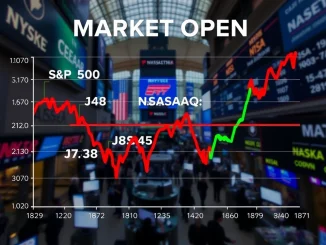
Hey crypto enthusiasts! While your primary focus might be on Bitcoin, Ethereum, and the latest altcoin movements, paying attention to the traditional financial world, especially the US stock market, is often a smart move. Today’s trading session wrapped up with mixed results for the major U.S. indices. Let’s dive into the numbers and discuss why this matters for your crypto portfolio.
Understanding the Latest Stock Market Close
The day concluded with two of the three major indices finishing slightly in the red, while one held steady. Here’s a quick look at the performance:
| Index | Performance Today |
|---|---|
| S&P 500 | -0.03% |
| Nasdaq | +0% |
| Dow Jones | -0.11% |
The S&P 500, often seen as a broad indicator of large-cap U.S. stock performance, posted a small loss. Similarly, the Dow Jones Industrial Average, representing 30 large publicly traded companies, also saw a minor dip. The tech-heavy Nasdaq Composite, however, managed to stay flat, showing resilience in the technology sector compared to the broader market.
Why Does the US Stock Market Matter to Crypto Investors?
You might wonder why a stock market close report appears in your crypto news feed. The truth is, traditional markets and the crypto market are increasingly intertwined. Here’s why watching the US stock market is relevant:
- Risk Sentiment: Stock market movements, especially major indices like the S&P 500 and Nasdaq, often reflect overall investor sentiment towards risk. When stocks fall, it can signal a decrease in appetite for riskier assets, which historically has included cryptocurrencies.
- Macroeconomic Factors: Both markets react to global economic news, inflation data, interest rate decisions by central banks (like the Federal Reserve), and geopolitical events. A negative reaction in the Dow Jones or Nasdaq could stem from factors that also negatively impact crypto prices.
- Institutional Flow: As more institutions invest in crypto, their decisions are often influenced by their broader portfolio performance and outlook on traditional markets. A weak stock market might lead some institutions to reduce exposure to volatile assets like crypto.
Decoding the Signal: What Today’s Stock Market Close Might Mean
Today’s performance, with the S&P 500 and Dow Jones slightly down and the Nasdaq flat, suggests a day of cautious trading rather than a major market panic. It wasn’t a dramatic sell-off, but it wasn’t a bullish surge either.
A flat Nasdaq is noteworthy because tech stocks often correlate more closely with crypto due to the growth-oriented nature of both sectors. The fact that it didn’t follow the slight downturn of the S&P 500 and Dow Jones could be interpreted in a few ways:
- Tech strength: Investors still see value in tech despite broader market weakness.
- Indecision: The market is waiting for more significant news before making a big move.
- Temporary decoupling: A brief period where tech (and potentially crypto) shows independent movement.
Actionable Insights for Crypto Holders
So, what can you take away from this stock market close?
- Stay Informed: Keep an eye on major economic indicators and how the US stock market reacts. It provides context for potential crypto price swings.
- Observe Correlations: Notice how Bitcoin and Ethereum prices move in relation to the Nasdaq and S&P 500 over time. Correlations aren’t always perfect, but patterns emerge.
- Manage Risk: Understand that external market factors can impact your crypto investments. Diversification (within crypto and potentially across asset classes) and setting stop-losses are tools to consider.
Conclusion: Connecting the Dots
Today’s relatively flat to slightly lower US stock market performance across the S&P 500, Nasdaq, and Dow Jones serves as a reminder that the crypto market doesn’t exist in a vacuum. While crypto has its unique drivers, macroeconomic winds and traditional market sentiment, reflected in the daily stock market close, can significantly influence its trajectory. Staying aware of these connections helps you build a more robust understanding of the market landscape.



